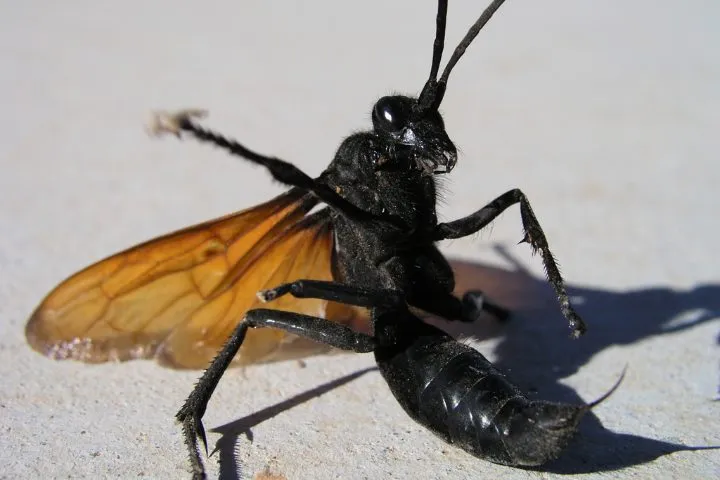What are Asian Giant Hornets?
The insect world is filled with fascinating creatures, and among the most intriguing are the Asian Giant Hornet (Vespa mandarinia) and the Tarantula Hawk Wasp (Pepsis grossa). This showdown explores the characteristics, behaviors, and dangers of these two formidable insects. The Asian giant hornet, often called the ‘murder hornet’ due to its aggressive behavior, is the world’s largest hornet species. These insects, with their imposing size and potent sting, have captured the attention of scientists and the public alike. Understanding these creatures is crucial not only for appreciating their unique place in the ecosystem but also for knowing how to interact with them safely.
Appearance and Physical Characteristics
The Asian Giant Hornet is instantly recognizable due to its enormous size. Queens can reach up to 2 inches (5 cm) in length, with workers being slightly smaller. Their appearance is striking a large orange or yellow head, dark mandibles designed for tearing flesh, and a striped abdomen of alternating brown and yellow bands. Their powerful build is a testament to their hunting prowess. The sheer size of the hornet allows it to overpower and hunt other insects. The massive mandibles of the Asian giant hornet are designed to tear through the exoskeletons of their prey, making it a formidable predator in its environment. These characteristics are crucial for its survival and are what separate it from many other insect species.
Habitat and Distribution
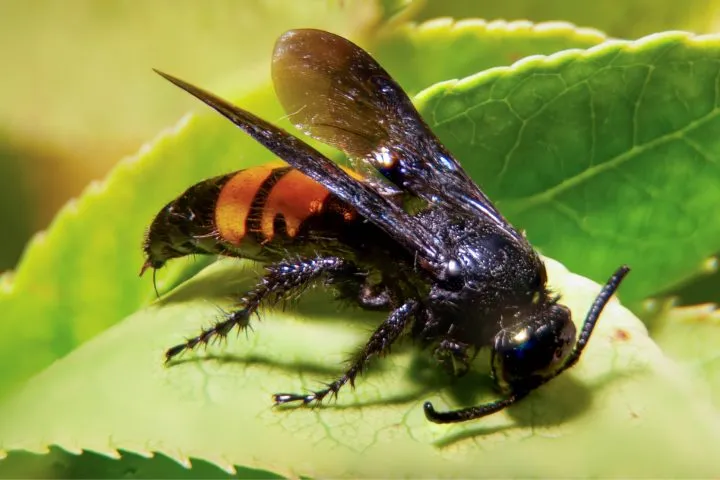
Asian Giant Hornets are native to East Asia, including regions of Japan, Korea, and China. They prefer to live in low mountains and forests, where they build nests, often underground or within rotting tree trunks. The recent spread of this species has caused concern. While these hornets are not typically found in large numbers, their presence is a signal of a potential environmental imbalance. Their habitat preferences are primarily driven by the need to build their nests in sheltered locations, which are often chosen to provide protection from the elements and other predators. The geographical distribution is critical as this insect may pose ecological impacts on local ecosystems that are not adapted to defend themselves against these predators.
Behavior and Diet
These hornets are ferocious hunters, preying on other insects, including honeybees, other wasps, and even mantises. They have been known to decimate entire honeybee colonies in a matter of hours, making them a significant threat to beekeeping operations. The Asian Giant Hornet’s hunting strategy is a coordinated attack, where they use their powerful mandibles to decapitate their prey. They feed on the thorax of insects, chewing and consuming the protein-rich parts, and carrying the parts back to their nests to feed their larvae. Their behavior is a testament to their predatory nature, which can have devastating impacts on the local ecology. The hornet’s diet is largely protein-based, which is necessary to support the energy needs of such a large and active insect.
The Tarantula Hawk Wasp Unveiled
Now, let’s shift our focus to the Tarantula Hawk Wasp, a remarkable insect known for its intense sting and unique hunting habits. The Tarantula Hawk Wasp is one of the largest wasps in the world, found primarily in the southwestern United States and parts of South America. This wasp is a solitary creature, and while it is less commonly known than the Asian Giant Hornet, it is equally, if not more, fascinating because of its unusual behavior. The Tarantula Hawk Wasp is a fearsome predator, and understanding its characteristics helps appreciate its place in the ecosystem.
Appearance and Identification
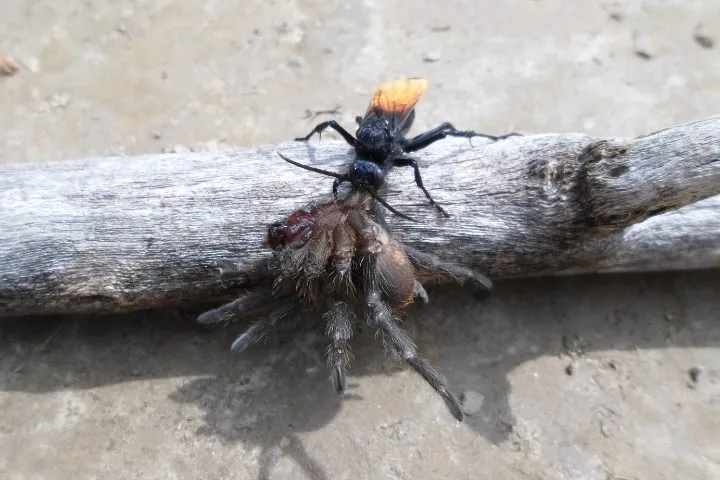
The Tarantula Hawk Wasp is typically 2 to 3 inches (5 to 8 cm) long. These wasps are brightly colored, with a black or bluish-black body and orange wings, which is a warning signal to predators. Their appearance is striking and helps with their identification. The wasp has powerful legs and jaws, necessary for their predatory lifestyle. The bright coloration serves a dual purpose, warning potential predators to stay away, and also as camouflage in their natural habitat. These wasps are easily recognized by their vivid colors and large size, setting them apart from other wasps.
Habitat and Range
Tarantula Hawk Wasps thrive in arid and semi-arid regions. They are most commonly found in the southwestern United States, including states like Arizona and New Mexico, but can also be found in South America. These wasps have adapted to survive in extreme environments, often preferring areas with sparse vegetation and sandy soils where they can find their prey. The habitat preferences are influenced by the distribution of their primary prey, tarantulas. They need the right conditions to hunt and reproduce. Their range is limited to areas that provide the right combination of climate, prey, and nesting sites.
Diet and Hunting Strategy
The Tarantula Hawk Wasp’s diet consists primarily of tarantulas, which they paralyze with their sting. This hunting strategy is where they get their name, as they are known to hunt tarantulas. The wasp then drags the paralyzed spider to a burrow, where it lays a single egg on the tarantula’s abdomen. The larva hatches and consumes the paralyzed spider alive. This strategy is a testament to the wasp’s survival skills. The wasp’s predatory behavior is considered one of the most painful insect stings. The hunting strategy is also a precise and efficient way to ensure the larva has an ample food supply, which helps to secure the survival of the next generation.
Hornet vs Wasp Key Differences
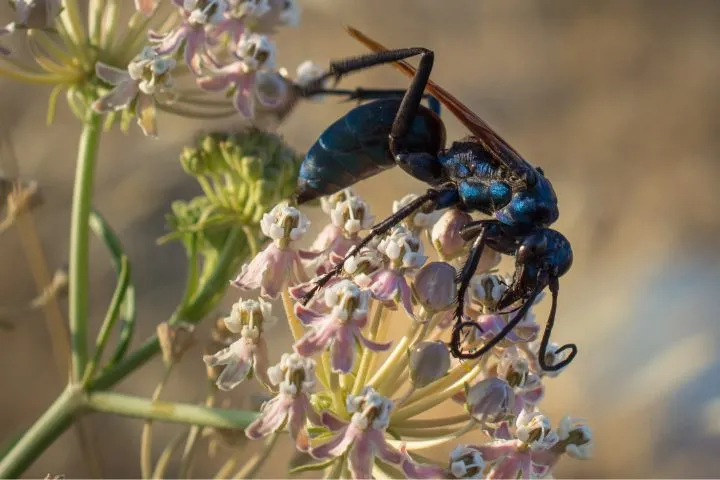
Size and Appearance
Both the Asian Giant Hornet and the Tarantula Hawk Wasp are large insects, but they have distinctive appearances. The Asian Giant Hornet is known for its large size, orange or yellow head, and striped abdomen. The Tarantula Hawk Wasp stands out with its black or bluish-black body and bright orange wings. Size is a key difference, but the distinct colorations of both insects offer clues to their behavior and habits.
Venom and Stings
The stings of both insects are potent and can cause significant pain. The Asian Giant Hornet’s sting can inject a large amount of venom, and can be dangerous due to its size and the amount of venom injected. The Tarantula Hawk Wasp’s sting is considered one of the most painful in the world, although it is not typically fatal to humans. The differences in venom composition contribute to the different effects of their stings. While both stings are painful, the nature of the pain, and the potential for allergic reactions can differ.
Aggression and Behavior
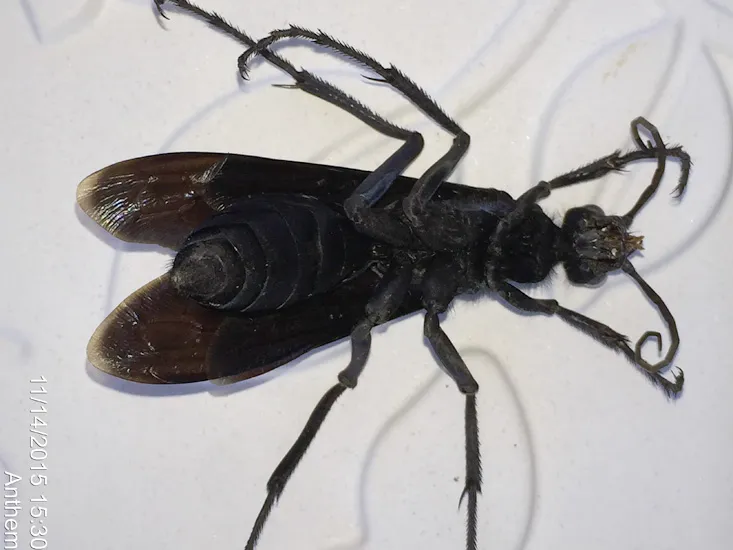
Asian Giant Hornets are known for their aggressive behavior, especially when defending their nests. They are more prone to attack when they perceive a threat. Tarantula Hawk Wasps are generally solitary and less aggressive towards humans, but they will defend themselves if threatened. The primary distinction lies in their approach to interactions. The Asian Giant Hornet’s aggressive defense strategies versus the Tarantula Hawk Wasp’s more measured response showcase different survival methods.
Hunting and Prey
The Asian Giant Hornet hunts a variety of insects, including honeybees, other wasps, and mantises. Their hunting strategy is to decimate nests. The Tarantula Hawk Wasp specializes in hunting tarantulas. Their ability to paralyze such a large prey showcases their unique hunting prowess. Each insect exhibits distinct predatory skills adapted to their specific prey, contributing to their roles in their ecosystems.
What’s More Dangerous?
Sting Potency and Toxicity
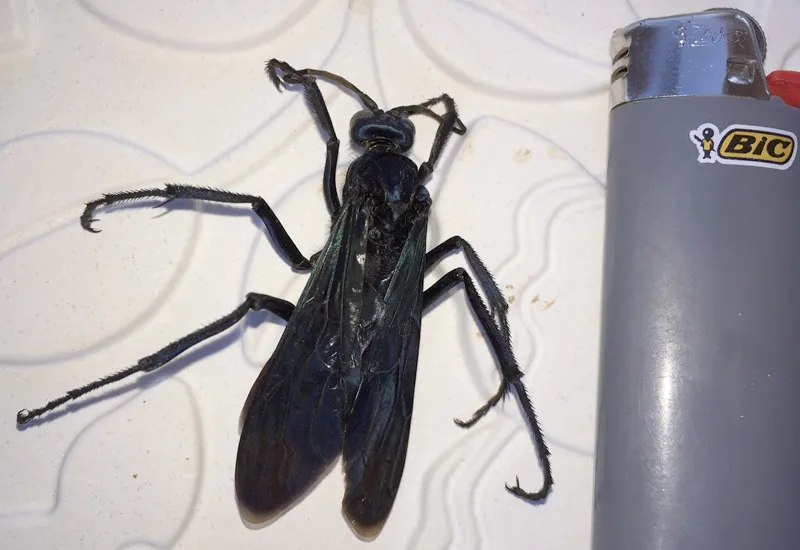
Assessing which insect is ‘more dangerous’ depends on the context. The Asian Giant Hornet’s sting contains a potent venom, and its large size allows it to inject a significant amount. This can cause severe pain, localized tissue damage, and allergic reactions. The Tarantula Hawk Wasp’s sting is infamous for its intensity, but the venom is not as toxic. The pain from a Tarantula Hawk Wasp sting is considered extremely agonizing, and this serves as a reminder of the natural world’s diverse threats. The overall danger depends on individual sensitivities, the amount of venom injected, and the location of the sting.
Impact on Ecosystems
Both insects play a significant role in their ecosystems. The Asian Giant Hornet is a predator that controls populations of other insects. The Tarantula Hawk Wasp controls the tarantula population. Their presence can help regulate the populations of their prey. The impact of both insects underscores the interconnectedness of ecosystems. They affect the populations of other species, the structure of food webs, and the overall health of the environment. Maintaining these predatory species is necessary for balance.
Interesting Facts
Both insects have fascinating adaptations and behaviors. The Asian Giant Hornet’s hunting strategy involves mass attacks on honeybee colonies. The Tarantula Hawk Wasp’s choice of prey is a large tarantula, which it drags to a burrow for its larva to feed on. These facts show the fascinating world of entomology. Each of these insects has unique traits. These adaptations contribute to their survival and highlight the remarkable diversity of life on Earth.
Defensive Strategies
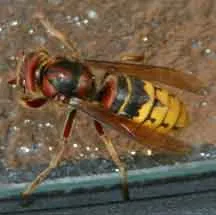
The Asian Giant Hornet and Tarantula Hawk Wasp possess distinct defensive mechanisms. Asian Giant Hornets defend their nests fiercely and can sting multiple times. The Tarantula Hawk Wasp’s bright coloration and painful sting are key defenses. Understanding the defensive strategies is crucial for avoiding encounters. The primary strategies used by these insects are designed for both defense and survival, contributing to their success in the natural world.
